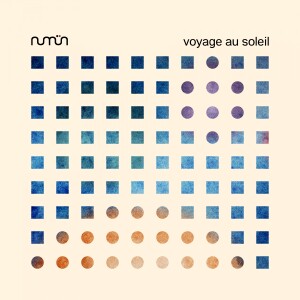 They had me at “Morton Subotnick.” The 1960s electronic music pioneer is listed as one of the influences of numün on voyage au soleil, their inaugural full-length release. I listened and was captivated.
They had me at “Morton Subotnick.” The 1960s electronic music pioneer is listed as one of the influences of numün on voyage au soleil, their inaugural full-length release. I listened and was captivated.
Numün is a New York-based trio of “soundscape designers” including Bob Holmes, Joel Mellin and Christopher Romero, who hail from curiously disparate musical backgrounds. Holmes has been in punkish bluegrass and country bands, went on to work as a producer with lots of independent country musicians, and is currently involved in the “ambient country” band SUSS, which somehow mixes Brian Eno and the late greate Ennio Morricone. Both Mellin and Romero are members of Gamelan Dharma Swara, one of the leading Balinese gamelan and dance groups in the United States; both are multi-disciplinary artists and Mellin is a former NASA engineer.
Aptly, this record began as part of a project to commemorate the 50th anniversary of the moon landing. The third track, “tranquility base,” was featured on the compilation The Moon and Back – One Small Step for Global Pop and released on the London-based alternative label WIAIWYA (“where it’s at is where you are”) in 2019. It grew from Holmes improvising on his guitar to a 45 rpm single of the recordings of the astronauts’ transmissions from the lunar surface. The group then filled out the album with an exploration of what the period around 1969 means to them, using a combination of American and Balinese instruments, synthesizers and loops.
It’s ambient, it’s soundscape, it’s collage and more, and I personally find this kind of thing a balm during these chaotic times. The project pivots around “tranquility base” so let’s start there. It fades in like radio static from outer space with a combination of high and low drones, bowed strings, occasional piano plucks and tabla taps. Then the looped voices of astronauts come in, starting with Neil Armstrong’s famous words “Tranquility Base here.” The sonic background ebbs, flows and shifts through sounds from languidly plucked guitars, ringing Balinese gongs, tablas, synthesizers, and lovely violin by Trina Basu of Brooklyn Raga Massive, as the voices of the astronauts and President Richard Nixon crackle through the static.
The album begins with the soothing “tranceport,” a wide-open sonic space of drones that’s punctuated by the disparate sounds of the cümbüş (described here as a fretless Turkish banjo) – at first back-masked and then straight, plus a Mellotron, an electric guitar (’52 Gibson hollow body), violin, and Balinese gongs.
Next up is “first steps,” which was the first single from the album. It’s simple, gorgeous and mesmerizing, simple acoustic guitar twang and a bit more of that cümbüş, over relaxed and soothing soundscape. Following “tranquility base,” the next track “mission loss” is quite a change of direction and pace, envisioned as a change of plans. No longer returning home to Earth, our sonic pioneers are off on their mission to the sun. It being with nearly three minutes of nerve-jangling electronic polyrhythms until a track of peaceful and twangy guitars fades in and persuades you that all is OK. “Expanse” continues this theme, with more Gibson twang set over a deep multiple layer of droning synths, gongs and a repetitive bass groove. It’s deeply trance-like but somehow manages to convey a continual forward motion. Which leads into the final, title track, deeply spacey and yet still somehow organic, the guitar and cümbüş strumming and twanging over layers and loops of drones – relaxed but rhythmic.
In spite of my early enjoyment of Subotnick’s all-electronic experimentation, I’ve not gone on to be a huge fan of electronica. I am, however, drawn to all kinds of music that combines acoustic and electronic in creative ways, whether that’s off-kilter folk that incorporates synthesized sounds or highly synthesized music like numün’s that includes lots of acoustic elements like guitars and violins, and blurs the lines between the two by incorporating gamelan, tabla, etc. Voyage au soleil is a deeply satisfying listening experience.
(Musique Impossible, 2020)
